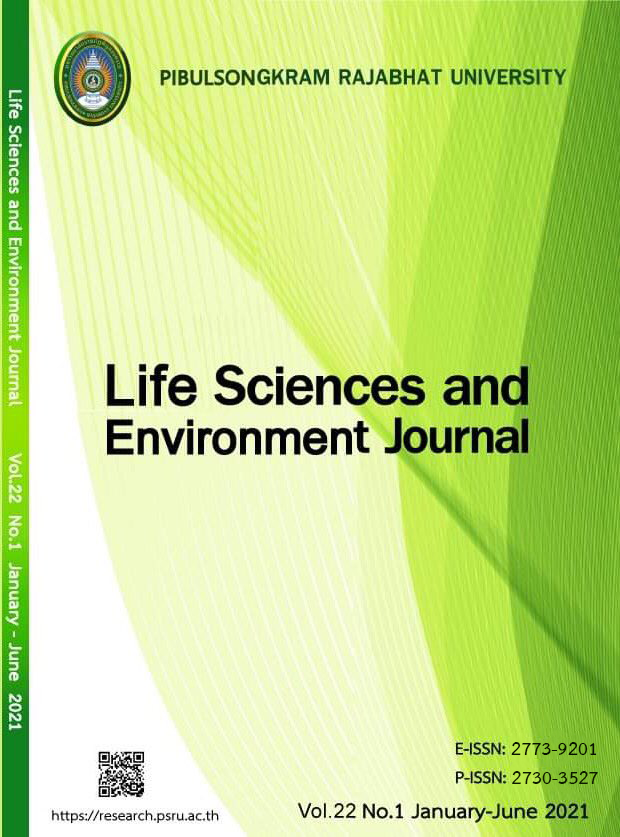THE STUDY ON GROWTH OF SIX CLIMBING PLANT SPECIES ON BRAIDED STEEL WALL FOR DEVELOPMENT TO A GREEN FACADES
Keywords:
Climbing plants, Green façade, Cover wallAbstract
An alternative for building design the environment is a green facade that can increase aesthetic value and help improving the weather. This research aimed to test the growth of climbing plant species in the pots on a high rise building and make suggestions on suitable plants. Six climbing plant species were found to be suitable for green facade building design. There are Thunbergia grandiflora, Antigonon leptopus, Lonicera japonica, Ipomoea purpurea, Dolichandra unguis-cati and Aristolochia ringens. The cover area from the leafs was evaluated by the Adobe(R) Photoshop(R). It was found that L. japonica had the highest average cover area of 50.9%, followed by A. leptopus, A. ringens and T. grandiflora with cover area of 44.8%, 39.1%, 34.7% and 30.6% respectively. D. unguis-cati was a minimum cover area of 31%. However, the average cover areas from six climbing plants were found to be not statistically different (p>0.05). Therefore, all six climbing plant species were suitable for establishing a green facade.
References
Boontia W, Teerawatananon A. Climber, Baanlaesuan publisher, Bangkok; 2011.
Cheng CY, Cheung K, Chu LM. Thermal performance of a vegetated cladding system on façade walls. Building and Environment 2010;45:1779-1787.
Erell E, Pearlmutter D, Williamson T. Urban Microclimate: Designing the space Between Building, London, Earthsan; 2011.
Grimm NB, Faeth SH, Golubiewski NE. et al. Change and the ecology of cities. Science 2018;319:756-760.
Heisler. Effects of individual trees on the solar radiation climate of small buildings. Urban Ecol 1986;9: 337-359.
Hunter AM, Williams NSG, Rayner JP. et al. Quantifying the thermal performance of green façades: A critical review. Ecological Engineering 2014;63:102-113.
Ip K, Lam M, Miller A. Shading performance of a vertical deciduous climbing plant canopy. Building and Environment 2010;45(1):81-88.
Jim CY. He HM. Estimating heat flux transmission of vertical greenery system. Ecological Engineering 2011;38(8):1112-1122.
Kiatiwateeratana A. Effectiveness in Reducing Heat to the Building Walls by Using Ivy on Boards, Thesis, Department of Architecture Graduate school Silpakorn University; 2011.
Koyama T, Yoshinaga M, Hayashi H. et al. Identification of key plant traits contributing to the cooling effects of green façades using freestanding walls. Building and Environment 2013;66:96-103.
MacIvor JS, Margolis L. Cooling of a South-Facing Wall Using a Double-Skin Green Façade in a Temperate Climate, Proceedings of the 2014 Annual Meeting of the International Plant Propagators Society; 2014.
Oke TR. The urban energy balance, Prog. Phys. Journal of Geography 1998;12:471-508.
Oliveir S, Andrade H, Vaz T. The cooling effect of green spaces as a contribution to the mitigation of urban heat: A case study in Lisbon. Building and Environment 2011;46(11):2186-2194.
Onishi A, Cao X, Ito T. et al. Evaluating the potential for urban heat-island mitigation by greening parking lots. Urban Forestry & Urban Greening 2010;9(4):323-332.
Osateerakul B, Thaipanit S. Design of algorithms for eliminating dead spots on plant leaf areas, Faculty of Business Administration and Information Technology Rajamangala University of Technology Suvarnabhumi; 2015.
Perez G, Coma J, Martorell I. et al. Vertical Greenery Systems (VGS) for energy saving in buildings: A review. Renewable and Sustainable Energy Reviews 2014;39: 139-165.
Price A, Jones EC, Jefferson F. Vertical Greenery Systems as a Strategy in Urban Heat Island Mitigation. Water Air Soil Pollut 2015;226:247.
Rayner JP, Raynor KJ. Williams NSG. Façade greening: a case study from Melbourne, Australia. Acta Horticulturae 2010;881:709-713.
Sulaiman MKAM, Jamil M, Zain MFM. et al. Shading Performance of Tropical Climbing Plant: Anemopaegma Chamberlaynii on Green Façade, SusTED’13, Malaysia; 2013.
Thai kasettakorn. Temperatur on Plant Growth, Kutyai publisher, Bangkok; 2017.
Wong NH, Tan AYK, Tan PY. et al. Energy simulation of vertical greenery systems. Energy and Buildings 2009;1(12):1401-1408.
Downloads
Published
How to Cite
Issue
Section
License
Each article is copyrighted © by its author(s) and is published under license from the author(s).










